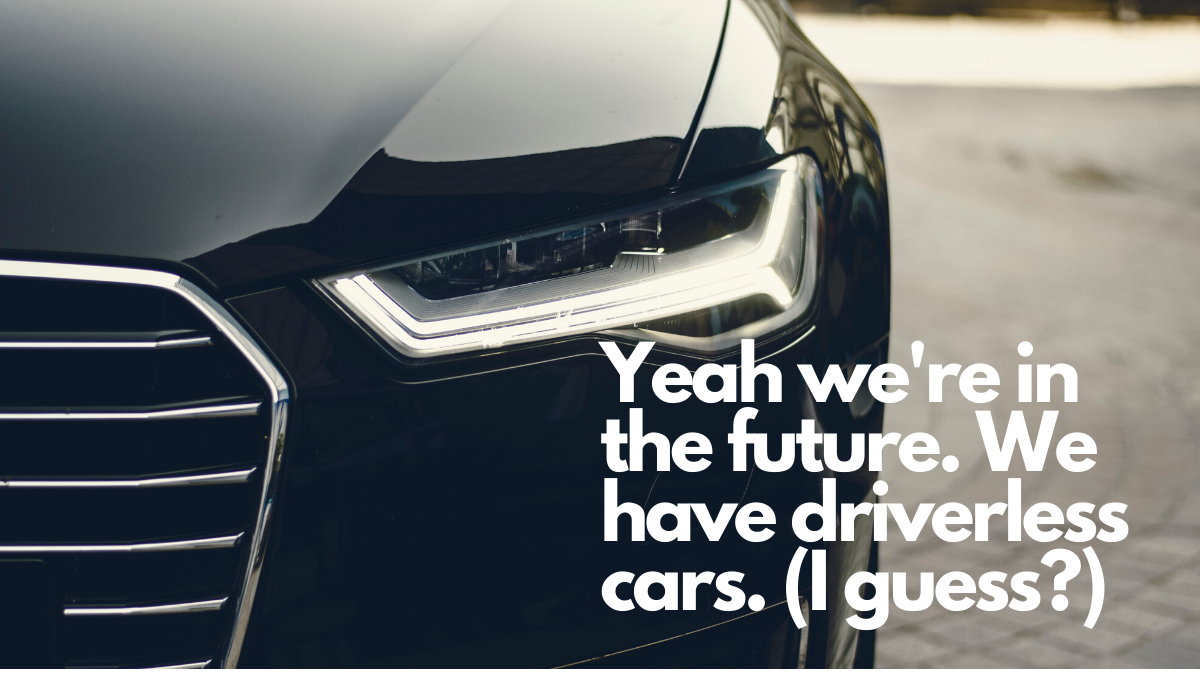So we’re now in 2020, and huge disappointment – no flying cars. But we almost have the next best thing – driverless cars. Or so they say. Every car company with a good marketing team or a crazy fan base (you know who I’m talking about) have been claiming they’ll be rolling out fully autonomous driving very soon. While some level autonomous driving has been introduced, full autonomy still seems miles away.
Let’s have a look at the current scenario
All the big names in the auto industry have been running after autonomous driving these past couple of years. Google has started offering paid rides on its driverless taxi service Waymo, Cadillac is offering supercruise with level 3 autonomy, Mercedes is offering drive pilot and Uber is working on its autonomous taxi service. But all this craziness began with Tesla.
Tesla, I think we could all agree, made electric cars sexy(I mean S3XY) and fast-forwarded the autonomous car revolution. With its huge fan following and an eccentric CEO, Tesla doesn’t have to pay for advertising. Tesla’s self-driving system referred to as the Autopilot is currently capable of keeping in the lane, changing lanes, emergency braking, adaptive cruise control, self-parking, and can be used to summon the car from a garage or parking spot. Tesla autopilot is a level 2 system, which means the driver must have their hands on the wheel at all times, which is something routinely ignored by drivers. Tesla has been expanding its range of products, and recently unveiled a radical new pickup truck named Cybertruck. And for people who have seen the thing, they’ll know why I call it radical. A never before seen design, with features guaranteed to catch everyone’s eye.
Volvo is another company that is working on self-driving tech but in a different manner. Even though Volvo has been developing autonomous cars, it has made some real strides in developing self-driving trucks for autonomous operation and has moved on from testing to fully operational mode. Their Vera Trucks are being used in towing containers in a port in Sweden and 6 FH trucks are being used in a Limestone mine in Norway. Even though they are being operated only in a small and closed environment, driverless trucks represent a key milestone where autonomous driving actually provides a benefit over human-operated vehicles. The trucks are networked and controlled over the cloud and minimize delays and improve efficiency. Tesla had also announced Tesla Semi in 2017, as an electric cargo truck with self driving capabilities. The promise of self-driving trucks is that a platoon of trucks will travel long distance guided by a single truck driven by a human.
Before Cybertruck, there were Rivian pickup trucks
Even before Tesla announced its cyberpunk Cybertruck, Rivian, an electric vehicle manufacturer made headlines with its electric pickup truck the R1T. Unlike the Cybertruck, the Rivian R1T looks like a regular pickup truck(I mean who needs bulletproof windows on their pickup?) and production is slated to begin in the second half of 2020. The Rivian electric pickup truck, as well as the Rivian SUV (R1S), may have a guardian mode, to assist passengers who may not be fully competent to drive the car(kids, senior citizens, etc) and Rivian has promised Level 3 autonomy on all its vehicles. Rivian trucks use a combination of LiDAR, GPS, RADARs, ultrasonic sensors and cameras for self-driving.
How do they work?
Autonomous vehicles use a combination of cameras and sensors to understand the environment around it. They also use highly detailed maps to navigate the roads. AI systems analyse the input from the different sensors to perceive the environment and make decisions based on the algorithms. Some systems use LiDAR, a light based RADAR, but some systems, like the Tesla Autopilot, relies mostly on its cameras.
LiDAR is highly effective but it is also very expensive. Autonomous cars are typically connected to the internet for frequent updates and may be used for live updates about traffic patterns and cloud processing. They have powerful onboard computers for processing the huge amount of data generated every second from the sensors.
What can 5G do? (Or 6G, as the Donald said)
5G internet is already here promising faster download speeds and lower latency. It could be key to another leap in autonomous driving. One of the major obstacles in autonomous driving or artificial intelligence as a whole is the high computing power required to run machine learning algorithms. While most other applications of machine learning systems can be run using cloud processing, the high data speeds and low latency required to make quick decisions in autonomous driving has long hampered its progress and led to some serious hardware requirements in each and every self-driving car. Applications of cellular technology in autonomous cars have been more or less limited to Over The Air updates and wireless data transfer to the overall improvement of the self-driving systems. A consistent 5G or maybe even faster networks, as well as improvements in cloud processing, could lead to the self-driving dream of a fleet of networked cars working in coordination.
I have a dream – about self-driving cars
All right let me tell you how I picture a full self-driving utopia. Fleets of cars moving in absolute coordination with millimeters of separation between them. As they reach an intersection, some cars move in different directions to join other fleets while new cars join this new fleet. There is no need to slow down there is no breaking, everything works smooth and in full coordination, like a ballet. Nobody owns cars anymore to catch a ride. They simply book a cab and a driverless car comes to your doorstep ready to take you to your destination. Am I looking forward to something like this? Hell yeah. Will I miss driving a car or riding a bike? Yeah, that too.
But let’s face it, the road to self-driving is filled with potholes and speed breakers.
Safety First
The thing about all these crazy marketing and twittering(Mr. Musk I’m looking at you) is that the people who get these cars have high expectations about the self-driving capabilities of these cars which can lead to accidents. Most of the cars that have self-driving capabilities currently have at best a level 2 (hands-on wheels, eyes on-road) or level 3 (driver intervention when asked by the system). But vehicle owners often tend to use these vehicles as if they are fully autonomous. While cars do have safeguards – for example, sensors on the steering columns to check if hands are on the wheel, after repeating warnings Autopilot on Tesla will be disengaged if they are not – they haven’t prevented accidents from happening.
Accidents involving self-driving cars raise other questions as well, questions not directly related to the technology. If a self-driving car is involved in the accident, who is to blame? The driver, the software, or the company that developed the car? These questions came up a lot recently when a self-driving car from Uber accidentally killed a woman in Arizona. In that case, it was almost easy to determine who was guilty (the backup driver was watching a movie on his phone). But it’s very evident it won’t always be the case always. This brings us to a lot of ethical issues that need to be resolved.
Oh, ethics. Fun
Another ethical issue that’s being discussed recently is the trolley problem. In the case of an accident should a driverless car act to save pedestrians who were passing by or sacrifice them to save the passengers. When humans drive, our reaction time is not fast enough to allow us to make decisions like this, but when autonomous cars become better than humans, there will definitely be many instances in which the car will have to make decisions like this. One of the largest studies about this asked people around the world questions related to this and answers showed some strong preferences. Cultural differences aside, most people preferred to save a group instead of individuals, save women over men. I was particularly disturbed to find that the majority chose to save dogs over humans. Mercedes recently announced that it would choose passengers over pedestrians, arguing that passengers are more likely to survive. This raises further questions, should people who decide this be the same people who make and sells these cars?
Regulating the tech.
Lawmakers are struggling to make regulations to deal with autonomous cars. As a technology that is still in its early stages with the potential to make dramatic and unknown effects on the future of transportation, rules regarding self-driving tech can be challenging to formulate. Currently, lawmakers around the world seem to be taking a go with the flow attitude, allowing automakers to test their self-driving tech on a case by case basis. And most of the current regulations are meant for testing self-driving tech and not regarding their use in a regular manner. Arizona, since 2015 only requires that the companies simply notify the state if they are testing, while Pennsylvania requires the companies to get permission from the Pennsylvania department of transportation and requires them to report where they are conducting the tests and any incidents or crashes related to the testing. California requires the companies to report information about the testing, such as the miles driven, the number of times the human driver had to take over, etc. Even then, most of the rules are loosely framed, often relying on the companies to self regulate. Since all of the companies are eager to make their self-driving system perfect as soon as possible, this could go either way. Companies may have stringent policies to avoid accidents and may encourage the drivers to take control even if they suspect something is amiss, since any untoward incident may result in the testing halted indefinitely. Or they may encourage the drivers to disengage the autonomous systems only at the last possible second, to decrease the number of disengagements. Either way, it has become clear with the incidents involving the Boeing 737 Max that self-regulation and self-certification are not going to work in the long term.
Money – Self-driving ain’t cheap brother
Currently, cars with self-driving capabilities are out of reach of the common man. The cheapest option from Tesla, the Model 3 with full self-driving capabilities cost around $10,000 more than an average car in the US. The high price of these cars is due to the hardware involved. They include a computer with high processing power, cameras, sensors. One of the most common tech used for self-driving tech, the LiDAR is almost prohibitively expensive. But the overall cost during the lifetime of the car has the potential to go down in the future. With better connectivity and improvements in cloud computing, the overall hardware required within the car can go down significantly, and the price of the car could go down accordingly. Tesla has hinted at plans to allow Tesla owners to let their cars be part of a robo taxi fleet, potentially generating revenue for them as the cars become fully self-driving. Under a full autonomy utopia, cars may become much more economical with energy savings by moving as a fleet, avoiding traffic jams and other delays. And with a solid infrastructure, the overall number of sensors and cameras on the car could also go down. And who knows, maybe people may not buy cars, preferring to use robotaxis which may essentially act as a train with groups of cars traveling together, splitting off, joining other groups to reach a destination faster and with huge energy savings.
It should be worth the money
For self-driving cars to be actually beneficial, to the car owners as well as society as a whole, there is a long way to go. Self-driving cars must reach at least a level 4 autonomy and must prove to be better than human drivers. While being as good as a human driver may be enough to make these cars safe, for the society as a whole, it’s pretty much the same result. More self-driving cars on the road and better algorithms should translate to fewer accidents and damage to people and property. The benefits of letting driverless vehicles to operate among people should outweigh its risks. Overall costs(both financial and environmental) involved, both for the cars themselves and the infrastructure required, should be substantially lower than that of conventional cars. As I write this, I can’t help but compare this to parents expecting 5-year-old kids to go to Harward or attend the Julliard when they are older. But machines are not humans, they won’t feel bad over undue pressure, or I hope so because else I’ll be in a bad situation when the AI overlords finally take over.
So when can we expect to see a level 5 autonomous vehicle?
As of now, none of the promises and predictions made by industry experts seem to be on track to fulfillment. It appears that self-driving is really really difficult to achieve. Most experts agree that a car that drives itself in all conditions is at least 10 years away. A measure of progress for different self driving cars could be the miles driven and the disengagements(the number of times the human driver had to take over) per mile. While there is no clearly defined definition on what counts as a disengagement, the numbers provide a rough estimate on the progress of self driving tech from different companies. Google’s Waymo is leading according to these numbers, reporting a disengagement rate of 1 every 11,017 miles. GM Cruise had a disengagement rate of one every 5204.9 miles. Waymo’s cars have driven around 20 million self driving miles on the road and more than a billion miles in simulation. Tesla self driving has an advantage here because of the sheer number of their cars on the road. Tesla’s self driving cars have driven around one billion miles so far in the autonomous mode.
But even after all these years of Autopilot in the airline industry, all takeoffs, as well as 99% of landings, are still being manually performed by the pilots and in the US, at least two pilots are required to be in the cockpit at all times. And the flight paths of planes are much less complicated (I mean you can’t crash on a lot of things when you’re up there) compared to the roads that could be travelled by car. So I can’t help but wonder if level 5 autonomy is even possible.




